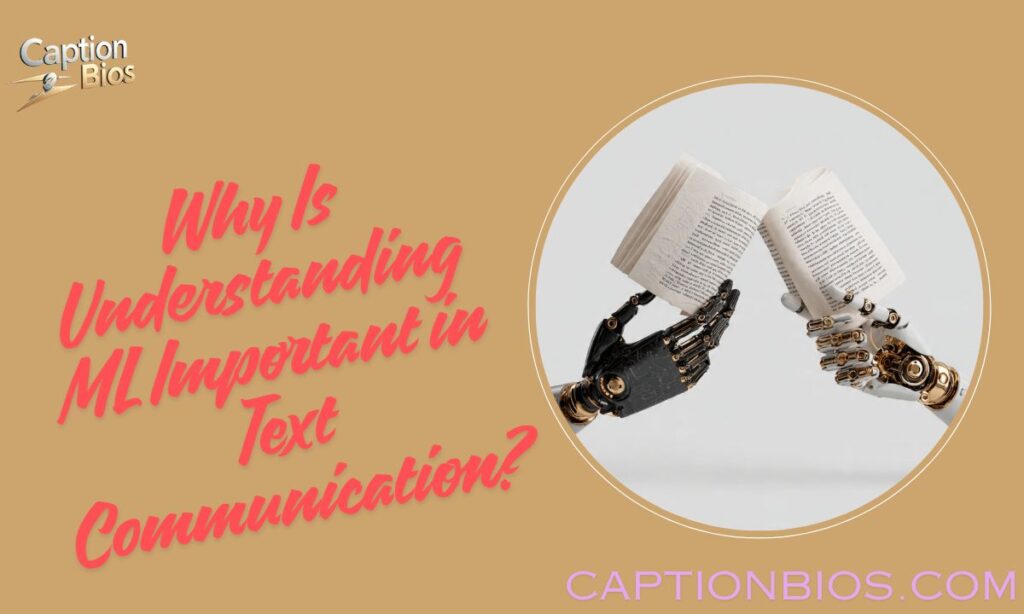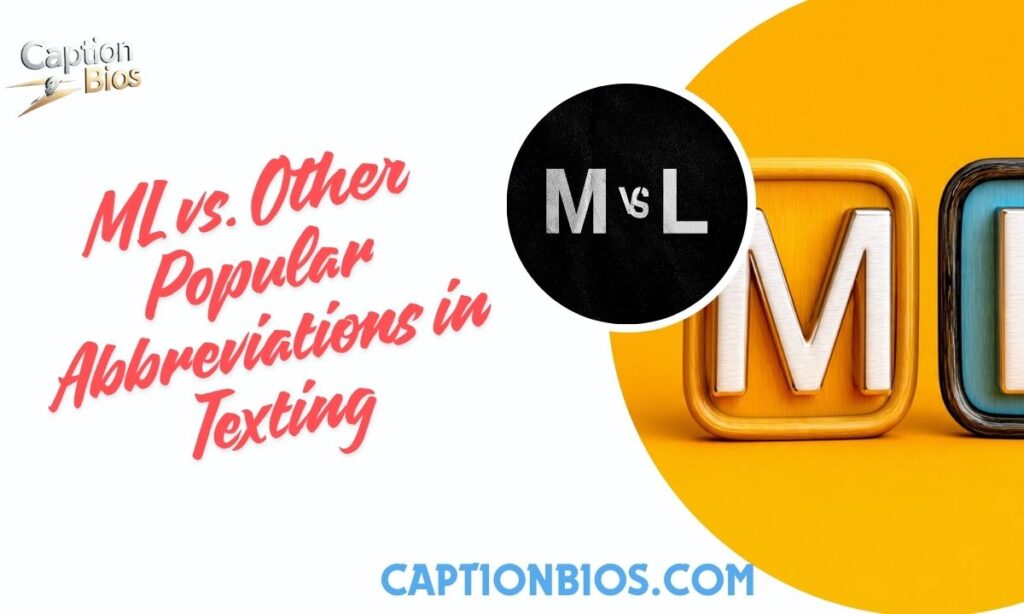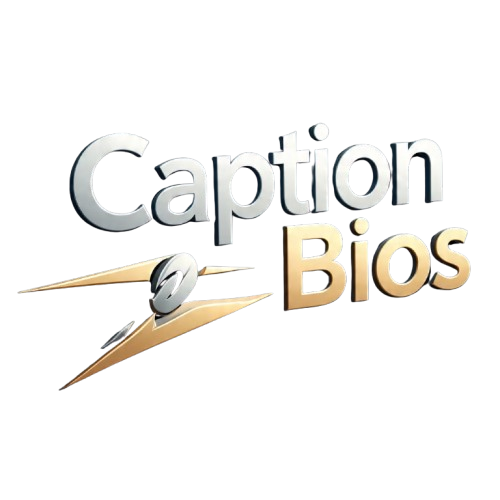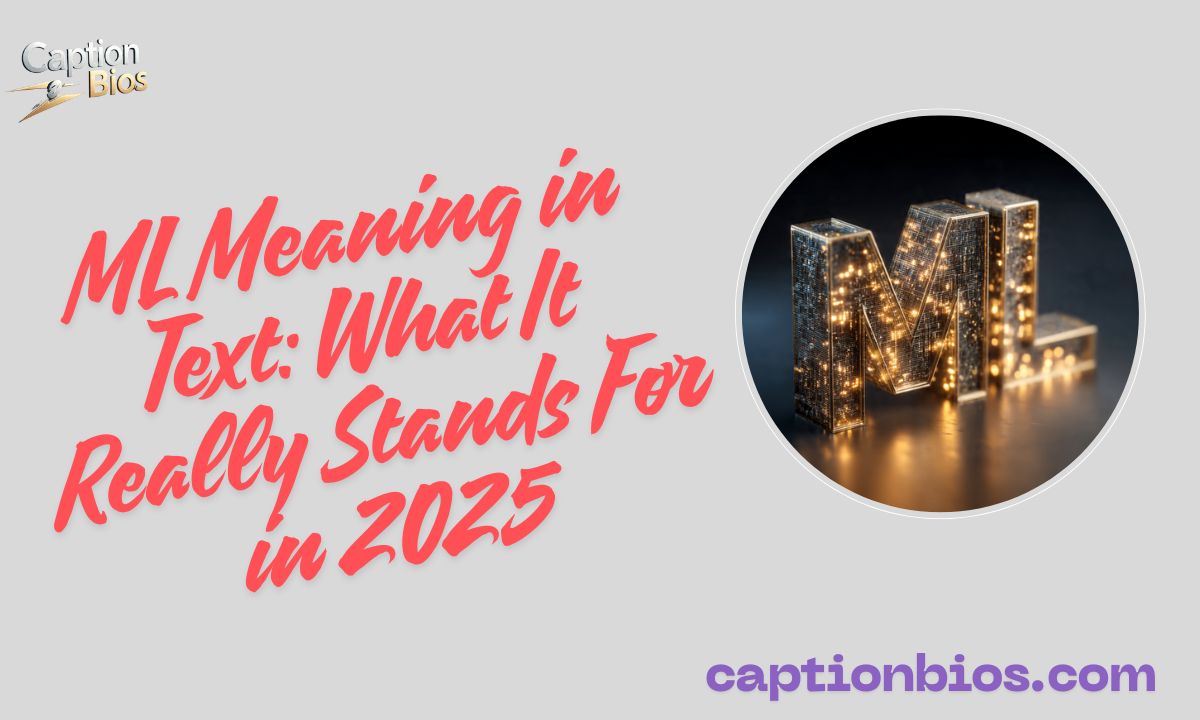ML in texting most commonly means “Much Love” – a warm way to end conversations with friends and family. In professional settings, ML usually stands for “Machine Learning,” especially in tech and business emails.
Romantic partners might use ML to mean “My Love,” making it deeply personal and intimate. The abbreviation can also mean “Mailing List” in office communications or “Minor League” in sports discussions.
What Does ML Mean in Texting?
The abbreviation “ML” in texting primarily stands for “Much Love”—a warm, affectionate expression commonly used to close conversations or show care and appreciation. This usage has become increasingly popular across social media platforms, text messaging, and instant messaging apps throughout 2025.
When someone ends a message with “ML,” they’re typically expressing positive emotions, gratitude, or a caring farewell. It’s the digital equivalent of giving someone a warm hug or saying “I care about you” without the formality of spelling out the entire phrase. This abbreviation has gained particular traction among younger demographics who value both emotional expression and efficient communication.
Expanded Meanings of ML in Text Communication
The versatility of “ML” becomes apparent when we examine its various interpretations across different contexts and industries. Understanding these multiple meanings is crucial for avoiding miscommunication and responding appropriately to messages containing this abbreviation.
1. Much Love (Social/Personal Context)
This remains the most prevalent usage of “ML” in personal communications. It’s frequently seen at the end of conversations, particularly when:
- Saying goodbye to friends or family
- Thanking someone for support or help
- Expressing appreciation for a meaningful conversation
- Showing solidarity or emotional support
- Closing social media posts or comments
The tone is warm, casual, and genuinely affectionate. For example: “Thanks for listening today. Really needed that. ML! 💕”
2. Machine Learning (Professional/Technical Context)
In professional, academic, and technical environments, “ML” almost exclusively refers to “Machine Learning”—the artificial intelligence technology that’s revolutionizing industries in 2025. This usage is common in:
- Tech company communications
- Academic research discussions
- Data science project updates
- AI development conversations
- Business strategy meetings
- Software development planning
Example: “The ML model showed 95% accuracy in the latest testing phase.”
3. My Love (Romantic/Intimate Context)
Between romantic partners or in intimate relationships, “ML” often stands for “My Love.” This usage is deeply personal and typically reserved for:
- Romantic partners
- Long-term significant others
- Married couples
- Close intimate friendships with established emotional boundaries
Example: “Can’t wait to see you tonight, ML 💖”
4. Mailing List (Business/Administrative Context)
In email communications and business settings, “ML” frequently refers to “Mailing List.” This usage is common when discussing:
- Email distribution groups
- Newsletter subscriptions
- Project communication lists
- Department update distributions
- Marketing campaign lists
Example: “Please add the new team members to the ML for weekly updates.”
5. Minor League (Sports Context)
Within sports discussions, gaming communities, and competitive environments, “ML” can represent “Minor League.” This usage appears in:
- Sports commentary and discussions
- Video game rankings and competitions
- Professional development contexts
- Skill level classifications
Example: “He’s definitely ready to move up from ML to the major leagues next season.”
6. Milliliters (Medical/Scientific Context)
In healthcare, scientific, or measurement-related communications, “ML” may stand for “milliliters.” This usage is found in:
- Medical prescriptions and instructions
- Laboratory communications
- Recipe sharing (especially baking)
- Scientific research discussions
Example: “The dosage should be 5 ML taken twice daily.”
Why Is Understanding ML Important in Text Communication?

In 2025’s hyper-connected world, misinterpreting abbreviations like “ML” can lead to significant communication breakdowns, professional embarrassment, and relationship complications. The importance of understanding these context-dependent abbreviations extends far beyond simple convenience.
Professional Implications
In workplace communications, confusing “Machine Learning” with “Much Love” could result in highly inappropriate responses that damage your professional reputation. Imagine responding to a technical email about ML algorithms with heart emojis, or misunderstanding a romantic “ML” as a business term. These misinterpretations can create awkward situations that are difficult to recover from.
Relationship Dynamics
Personal relationships rely heavily on understanding emotional cues and intentions. When someone sends “ML” in a romantic context, responding as if it were casual friendship communication can hurt feelings and create confusion about relationship boundaries. Conversely, over-interpreting a friendly “ML” as romantic interest can lead to uncomfortable situations and potential relationship damage.
Cultural and Generational Considerations
Different age groups, cultural backgrounds, and social circles may have varying interpretations of “ML.” What seems obvious to a Gen Z user might be completely foreign to a Baby Boomer, and what’s appropriate in one cultural context might be misunderstood in another. Understanding these nuances helps bridge communication gaps across diverse groups.
Digital Platform Context
The meaning of “ML” can also vary depending on the platform. LinkedIn messages require different interpretation than Instagram DMs, and Discord gaming chat has different conventions than formal email communications. Platform-aware communication is essential for modern digital literacy.
Avoiding Miscommunication Costs
Miscommunication in today’s fast-paced world can have real costs—missed business opportunities, damaged relationships, lost time clarifying misunderstandings, and reduced trust in professional settings. Investing time in understanding abbreviations like “ML” pays dividends in clearer, more effective communication.
How to Choose the Right Meaning of ML
Determining the correct interpretation of “ML” requires developing strong contextual awareness and communication intuition. Here’s a systematic approach to decoding “ML” in any situation:
Context Analysis Framework
Examine the Platform: Different platforms have different communication norms. LinkedIn suggests professional meanings, while Snapchat or Instagram typically indicate personal interpretations.
Consider the Sender: Your relationship with the person sending “ML” is the strongest indicator of meaning. Close friends likely mean “Much Love,” while colleagues probably mean “Machine Learning” or “Mailing List.”
Review the Conversation Topic: If you’ve been discussing technology, data, or business projects, “ML” probably means “Machine Learning.” If the conversation has been personal, emotional, or supportive, “Much Love” is most likely.
Look for Additional Context Clues: Emojis, surrounding words, and conversation tone provide valuable hints. Heart emojis suggest “Much Love,” while technical terminology points to “Machine Learning.”
Consider Timing and Frequency: “ML” at the end of conversations often means “Much Love,” while “ML” in the middle of technical discussions usually means “Machine Learning.”
Decision-Making Flowchart
- Is this a professional/technical context? → Likely “Machine Learning” or “Mailing List”
- Is this a personal conversation with emotional content? → Likely “Much Love”
- Is this from a romantic partner? → Possibly “My Love”
- Are we discussing sports or competitions? → Possibly “Minor League”
- When in doubt, ask for clarification → Always acceptable and professional
Clarification Strategies
When uncertain about “ML” meaning, use these polite clarification approaches:
- “Just to clarify, are you referring to machine learning or…?”
- “Could you expand on what you mean by ML in this context?”
- “I want to make sure I understand correctly—ML means…?”
12 Polite, Professional, and Casual Ways to Say “ML”
Rather than relying solely on abbreviations, consider these alternatives that provide clarity while maintaining appropriate tone for different situations:
Casual/Friendly Alternatives (Personal Relationships)
1. “Sending you lots of love” – Warm and caring without being overly intimate, perfect for close friendships and family relationships.
2. “Take care and much love” – A gentle, nurturing farewell that shows genuine concern for the recipient’s wellbeing.
3. “Love and positive vibes your way” – Modern, uplifting language that resonates with younger audiences while maintaining emotional warmth.
4. “Hugs and love from here” – Combines physical and emotional affection in a way that feels personal but not romantic.
Professional/Workplace Alternatives (Business Context)
5. “Best regards and appreciation” – Professional yet warm, showing respect while maintaining business boundaries.
6. “Thank you with warm wishes” – Acknowledges contribution while adding a personal touch that’s still workplace-appropriate.
7. “Gratefully yours” – Formal but heartfelt, perfect for mentor relationships or appreciative business communications.
8. “With sincere appreciation” – Highly professional while conveying genuine gratitude and respect.
Romantic/Intimate Alternatives (Partner Relationships)
9. “Forever yours with all my heart” – Deeply romantic and committed, appropriate for serious relationships and marriage.
10. “You have all my love always” – Expresses complete emotional devotion in a timeless, elegant way.
11. “My heart is with you” – Poetic and intimate, perfect for long-distance relationships or emotional moments.
12. “Endlessly yours, my love” – Combines commitment with romantic endearment in a way that feels both classic and modern.
Technical/Specific Context Alternatives
When referring to machine learning, mailing lists, or other specific meanings, always spell out the full term in professional communications to avoid confusion.
Examples of How to Use ML in Different Conversations
Understanding theoretical meanings is valuable, but seeing “ML” in action across various real-world scenarios helps solidify proper usage and interpretation.
Friendship Context (Much Love)
Scenario: Your best friend just helped you through a difficult breakup.
Message: “I don’t know what I’d do without you. Thanks for being there through everything. You’re incredible. ML! 💕”
Analysis: Clear emotional context, close relationship, supportive situation, and heart emoji all indicate “Much Love.” This usage strengthens friendship bonds and expresses genuine gratitude.
Workplace Context (Machine Learning)
Scenario: Team meeting about implementing new technology solutions.
Email: “Subject: Q4 ML Implementation Timeline – The ML rollout is scheduled for next month. We’ll need the data science team to finalize the ML algorithms before we can proceed with user testing.”
Analysis: Professional setting, technical subject matter, and business context clearly indicate “Machine Learning” throughout. No emotional content or personal relationship dynamics present.
Romantic Context (My Love)
Scenario: Long-distance relationship couple staying connected.
Text: “Just finished work and thinking about you. Can’t wait for Friday when you’re here. Miss you so much, ML 😘💕”
Analysis: Romantic relationship, emotional content, intimate tone, and romantic emojis suggest “My Love.” The personal nature and relationship context support this interpretation.
Business Context (Mailing List)
Scenario: Office administrator organizing project communications.
Email: “Please ensure all new project stakeholders are added to the ML by end of day. The weekly updates go out every Tuesday, and we don’t want anyone to miss important information.”
Analysis: Administrative context, business process discussion, and practical organizational content indicate “Mailing List.” No emotional or technical AI content present.
Sports Context (Minor League)
Scenario: Fantasy sports discussion among friends.
Group Chat: “Thompson’s numbers in ML were solid this season. Think he’s ready for the majors? Could be a great draft pick next year.”
Analysis: Sports discussion, competitive context, and performance evaluation suggest “Minor League.” The conversation focuses on athletic development and career progression.
Mixed Context Challenge
Scenario: Tech startup where personal and professional boundaries blur.
Slack Message: “Great job on the ML presentation today! Really impressed with the team’s progress. ML to everyone who stayed late! 🔥”
Analysis: This challenging example shows why context matters. The first “ML” clearly refers to “Machine Learning” based on presentation context. The second “ML” likely means “Much Love” based on emotional appreciation and fire emoji, though workplace relationships complicate interpretation.
When NOT to Use ML
Understanding when to avoid “ML” is just as important as knowing how to use it correctly. Certain situations require more formal, specific, or clear communication approaches.
Formal Documentation and Legal Contexts
Never use “ML” in formal documents, contracts, legal communications, or official business correspondence. These contexts require complete clarity and professional language standards. Ambiguous abbreviations can create legal complications or professional misunderstandings.
Cross-Cultural and International Communications
When communicating with international colleagues, clients, or friends from different cultural backgrounds, avoid “ML” unless you’re certain of mutual understanding. Cultural differences in emotional expression and professional boundaries mean abbreviations can be easily misinterpreted.
New Professional Relationships
Avoid using “ML” with new colleagues, clients, or professional contacts until you establish appropriate communication norms. Starting with formal language and gradually adapting to accepted workplace culture prevents early relationship missteps.
Hierarchical Professional Settings
In communications with supervisors, executives, or formal authority figures, avoid emotional abbreviations like “ML” unless the workplace culture explicitly encourages casual communication. Err on the side of formality in hierarchical relationships.
Crisis or Sensitive Situation Communications
During emergencies, conflicts, or sensitive discussions, clarity trumps convenience. Avoid abbreviations that might be misinterpreted when stakes are high or emotions are involved.
Educational and Academic Contexts
Unless specifically discussing machine learning in academic contexts, avoid “ML” in educational communications. Students, professors, and academic administrators typically expect clear, formal communication standards.
ML vs. Other Popular Abbreviations in Texting

Understanding “ML” within the broader context of text abbreviations helps develop better digital communication skills and avoid common confusion patterns.
Emotional Expression Abbreviations
ILY (I Love You): More direct and intense than “ML.” Reserved for romantic relationships or very close family bonds.
XOXO (Hugs and Kisses): Similar warmth to “Much Love” but more playful and less emotionally weighty.
BFF (Best Friends Forever): Friendship-specific, while “ML” can apply to various relationship types.
TTYL (Talk To You Later): Casual farewell without emotional content, contrast to “ML’s” affectionate tone.
Professional Communication Abbreviations
FYI (For Your Information): Neutral, informative tone contrast to “ML’s” emotional warmth.
ETA (Estimated Time of Arrival): Practical, business-focused, no emotional content.
ASAP (As Soon As Possible): Urgent, business-oriented, potentially stress-inducing contrast to “ML’s” positive tone.
EOD (End of Day): Time-specific, business context, formal tone.
Platform-Specific Variations
Different social media platforms and messaging apps have developed unique abbreviation cultures. Instagram and Snapchat users might interpret “ML” more casually, while LinkedIn users expect professional meanings. Discord gaming communities might have completely different abbreviation norms than Facebook family groups.
Generational Differences
Gen Z users tend to create and adopt new abbreviations rapidly, while older generations may stick to established meanings. “ML” interpretations can vary significantly across age groups, requiring audience-aware communication approaches.
Language Tip: Use Tone-Appropriate Variations of ML
Mastering “ML” usage requires understanding how to adapt your communication style to match your audience, relationship, and context appropriately.
Audience-Specific Adaptations
For Close Friends: Feel free to use “ML” casually with heart emojis, GIFs, or other emotional expressions that match your friendship dynamic.
For Family Members: “ML” works well with family, but consider individual family members’ communication preferences. Some relatives might prefer more traditional expressions.
For Romantic Partners: “ML” as “My Love” or “Much Love” can be appropriate, but vary your expressions to maintain relationship freshness and emotional authenticity.
For Professional Acquaintances: Avoid “ML” in professional contexts unless you’re certain about workplace culture and relationship boundaries.
Contextual Tone Matching
Celebratory Contexts: “ML” can enhance congratulatory messages and positive communications when relationships support emotional expression.
Supportive Contexts: During difficult times, “ML” can provide comfort and emotional support, but ensure the recipient appreciates this communication style.
Casual Daily Communication: “ML” works well in everyday friendly conversation but shouldn’t become a thoughtless habit that loses emotional impact.
Cultural Sensitivity Considerations
Be aware that emotional expression norms vary across cultures. What feels warm and appropriate in one cultural context might seem inappropriate or overly familiar in another. When in doubt, observe and mirror the communication styles of people from different cultural backgrounds.
Summary: How to Use “ML” Smartly in Texts
Effective “ML” usage in 2025 requires balancing efficiency with clarity, emotion with appropriateness, and personal expression with professional boundaries.
Key Principles for Smart ML Usage
Context is King: Always consider the platform, relationship, and conversation topic before interpreting or using “ML.” The same abbreviation can have completely different meanings and appropriateness levels depending on context.
Relationship Awareness: Your connection with the recipient should guide your “ML” usage. Close friends and family can handle casual emotional expression, while professional relationships require more careful consideration.
Cultural Sensitivity: Be mindful of generational, cultural, and regional differences in abbreviation interpretation. What’s obvious to you might be confusing or inappropriate to others.
Professional Boundaries: Maintain clear distinctions between personal and professional communication styles. “ML” as “Much Love” rarely belongs in workplace settings, while “ML” as “Machine Learning” rarely belongs in intimate personal conversations.
Clarity Over Convenience: When in doubt, spell it out. The few extra seconds spent typing complete phrases can prevent hours of confusion and relationship complications.
Best Practices for 2025 Digital Communication
Develop Platform Awareness: Different social media platforms, messaging apps, and communication tools have unique cultural norms around abbreviations and emotional expression.
Practice Active Clarification: Don’t hesitate to ask for clarification or provide it when using potentially ambiguous abbreviations like “ML.”
Maintain Authentic Voice: While understanding abbreviation norms is important, ensure your communication style remains authentic to your personality and values.
Stay Updated: Digital communication evolves rapidly. Stay current with new abbreviation meanings and usage changes to maintain effective communication skills.
Balance Efficiency and Connection: Use abbreviations like “ML” to enhance communication efficiency, but don’t let convenience replace genuine emotional expression and relationship building.
Frequently Asked Questions
What is the most common meaning of ML in texting?
The most common meaning is “Much Love,” used as a warm and affectionate way to end conversations.
Can ML mean something different in work emails?
Yes, in professional contexts, ML typically stands for “Machine Learning” or “Mailing List” depending on the discussion topic.
Is it appropriate to use ML with everyone?
No, ML should only be used with people who understand the context – avoid it in formal communications or with new contacts.
How do I know which meaning of ML someone is using?
Look at the conversation context, your relationship with the sender, and any surrounding words or emojis for clues.
What should I do if I’m unsure about ML’s meaning?
Simply ask for clarification – it’s always better to ensure understanding than to misinterpret the message.
Conclusion
Understanding ML in text communication is essential for effective digital interaction in 2025. Whether it means “Much Love,” “Machine Learning,” or any other interpretation, the key lies in reading the context and considering your relationship with the sender.
As digital communication continues to evolve, staying aware of these multi-meaning abbreviations helps prevent misunderstandings and strengthens both personal and professional relationships.
Muhammad Shoaib is a creative writer with over 5 years of experience crafting impactful captions, memorable quotes, and clever pick-up lines that spark engagement and emotion. As the lead content expert at CaptionBios.com, Shoaib helps people express themselves with style, humor, and authenticity across social media and messaging platforms.






Leave a Reply